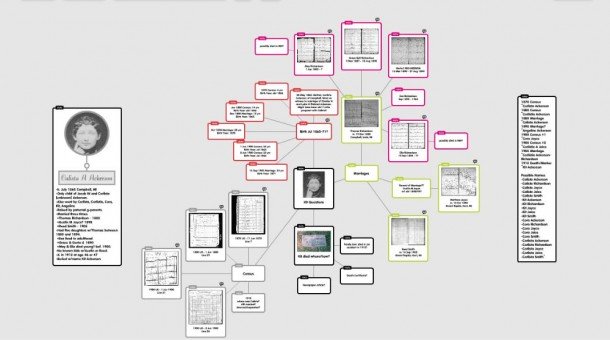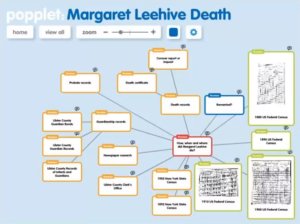We all know what a Family Tree is, right? But what about Genealogy? Sounds like homework right? Well, in a way, it is! A family tree is a visual representation of our ancestors: parents, great grandparents and so on, which can also contain useful information such as where a person lived and how they died.
Genealogy on the other hand, could be said to be all the work that goes into creating family trees – a lot of work in most cases, and like most trees, the roots are infinitely more vast than the tree itself, and are often twisted and buried deep below ground and hard to find. Unearthing and unravelling these roots is the work of the genealogist.
To create accurate family histories, genealogists must find the answers to many questions, often with only very small amounts of information. It is work that requires research, organization and collaboration. The growth of the internet has meant that the amount of resources available to genealogists has increased enormously, and has now led to genealogy being considered one of the most popular activities on the internet!
But how to store all of these family research records when they are uncovered? How can genealogists keep track of their research and map out family trees that draw from a combination of archival documents, text notes, links, and photos? Popplet of course!
The Detective
Quality research is the key to success in genealogy. Genealogists are detectives who must examine all the evidence they find, determine it’s value, and keep vital records. And, just like detectives, they need their moments of clarity; those a-ha! times when it all comes together. These moments may be inspired, but as any detective will tell you, they are really the result of solid footwork. Popplet provides a visual platform where the fruits of this work can be stored, constructed, studied and shared.
One of the key resources used by genealogists and family tree hobbyists around the world is the Legacy Family Tree Webinar, Mind Mapping your Research Plans and Results, by genealogy and technology expert Thomas MacEntee.
Mr MacEntee demonstrates how he uses “mind mapping platforms” in his genealogy work. He lists the advantages of using Popplet for mind mapping when compared to more traditional methods:
- More efficient organization of data, preventing repeat research
- Information can be organized into visually, easier to solve problems
- “Action items” and the thought process can be visualized
- Visualization of evidence: “does it fit or doesn’t it?”
- Visualization of pathways to solutions
- Use of colors
- Use of images for focus and meditation.
Mr MacEntee describes Popplet as “one of the easier programs” and he “really recommends it”, favoring Popplet over other “mind mapping programs which are very complex”. Here’s an example of how he is using Popplet in his current research into his great-great-grandmother, Margaret Leehive:
Here’s how he does this research:
- He begins with a question at the center: “How, when and where did Margaret Leehive die?”, to provide focus
- Colors differentiate topics, and separate research areas
- Links provide clear connections to sub-topics
- Copies of original census documents appear, as images can be easily uploaded to Popplet
- Popplet’s note adding facility is used either to record important information or to ask himself important questions
- He uses Popplet to share with other researchers, finding it far more productive to use an image to show his thinking and progress when collaborating on research
- He also mentions the many other ways that Popplet is useful such as embedding, sharing, creation of PDFs and JPEGs.
When It All Comes Together
Self-confessed “genealogy lover and history nut” PastSmith believes that using Popplet for family tree research may itself bring about those moments of inspiration so highly coveted by detectives. (PastSmith’s Family Tree research is shown in the Popplet at the top of this blog post.)
Intrigued by Mr MacEntee’s Webinar, PastSmith set out see if Popplet was all that it was cracked up to be. PastSmith was “blown away” by the results of adding a visual dimension to the genealogy research with Popplet. Using colors, uploading records and linking facts to create a visual flow of an ancestor’s life, PastSmith was able to instantly see what was missing from the research conducted: “a Eureka moment” that provides “new vantage points” and a fresh way of thinking.
Are you using Popplet in your genealogy research? How is Popplet inspiring your research? Share your experiences with us, and our community on Twitter and on our Facebook page.

